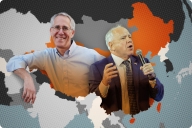You have /5 articles left.
Sign up for a free account or log in.
Advocates for international exchange have organized to protest what they describe as an “unprecedented” $30.5 million cut to the Fulbright program included in President Obama’s proposed budget. While the proposed budget, released earlier this month, includes an overall 1.6 percent increase in funding for the U.S. State Department’s international educational and cultural exchange programs, it cuts funding for the flagship Fulbright program by 13 percent, from $234.7 to $204.2 million.
At the same time, the proposed $577.9 million exchanges budget includes funding for three new programs: $20 million for the Young African Leaders Initiative, $10 million for the Young South-East Asian Leaders Initiative, and $2.5 million for Fulbright University – Vietnam, which is described in the budget justification document as supporting “academic freedom and autonomy in developing new curricula.”
“Those initiatives are only to be praised,” said Lonnie Johnson, executive director of the Austrian-American Educational Commission, which is one of about 50 binational commissions that jointly administer Fulbright awards. But he worries about funding them at Fulbright’s expense. Johnson, who emphasized that he was speaking in a personal capacity and not on behalf of the Austrian-American commission, said he worries about the symbolic effects of the proposed cut. “The program has a global reputation as the flagship academic exchange program of the United States of America,” he said. “Why do something to devalue the enormous symbolic and political capital that the Fulbright program has?”
Foreign government partners share in the cost and administration of the Fulbright program, funding it to the tune of more than $84 million in direct and in-kind support in fiscal year 2011. Private sources in foreign countries contributed another $17 million.
“Given the fact that the unilateral cuts of this nature go substantially beyond the ones that have been recently made with the routine justification of ‘budgetary constraints,’ they will be uniformly ill received by those partner governments and countries all over the world that are making substantial contributions of over $100 million annually to the Fulbright Program, and in many commission-based countries these contributions to the Fulbright Program are substantially higher than... those of the US government itself,” Johnson wrote in an open letter.
Yussi Pick, a Fulbright alumnus from Austria who was a German teaching assistant at the College of Wooster, in Ohio, spearheaded the creation of the SaveFulbright.org website and petition, which has attained more than 7,500 signatures. “Most of the people who signed the petition are alumni of the program and every single one of them has a story and every single one of them, not only was their life touched by the Fulbright program, they touched other lives,” Pick said.
Susan Pittman, a spokeswoman for the State Department’s Bureau of Educational and Cultural Affairs, said the shift in funding away from Fulbright is reflective of a desire to offer more responsive programming. The State Department wants to be better poised to create rapid-response, “on-demand” type programs in response to crisis situations that might arise in the world – in Ukraine, for instance.
“There were some strategic shifts I would say in order to be able to take a different angle of doing some short-term targeted programs,” she said. “To that end there was the desire to be able to redistribute things.”
That said, Pittman added that Fulbright remains the State Department’s biggest and premiere program. “We will be continuing to look at it as the flagship, the premiere, and the cutting edge of our exchange programs.” She said it was too early to know how the proposed cuts, if approved by Congress, would be distributed across the Fulbright programs.
Appropriated funding for the State Department’s exchange programs has increased about threefold from $205 million in fiscal year 2000 to $602.5 million in fiscal year 2013, followed by a sequester-related dip to $568.6 million in fiscal year 2014. The peak year for funding was $635 million in fiscal year 2010.
“Fulbright has been one of the flagship U.S. exchange programs for decades and it’s one of the flagships for a reason: it’s effective, it’s cost-effective, you’re reaching future leaders across a whole range of disciplines,” said Michael McCarry, executive director of the Alliance for International Educational and Cultural Exchange, which lobbies on behalf of more than 80 international education organizations. “Having said that, I think the new initiatives are really good ideas, but the Alliance’s perspective is we’ve got to be able to do all of this, and we could do all of this within the budget levels we’ve had in recent years.”








